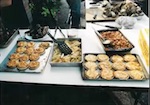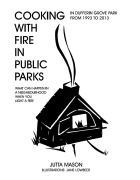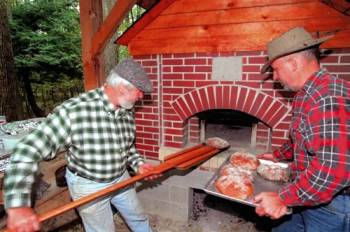Comments?
For the basics, see
- Website & Privacy Policies
- How To Get Involved
- The Role of the Park
Search options:
Department Site Map
Custodians:
posted on October 04, 2008
Local baker shaping a bread tradition
By: Marlene Parrish
Published: October 02, 2008
Source: Post-Gazette
In 1998, Ray Werner, left, pulls bread from the oven that
Mike Schafer, right, built for him.Baking bread in a brick oven awakens your past. It takes you back to who you are.
-- Lionel Poilane
Pittsburgh's love affair with bread took off in 1979 when Tom McMahon founded Breadworks on the North Side. The bakery pioneered the first truly artisanal bread in our community with its European-style breads. Mr. McMahon then went on to found the Bread Bakers Guild of America. More recently, local baker Nick Ambeliotis of Mediterra Bakehouse has continued the tradition of making artisanal bread.
It is Ray Werner's passion that may soon take our city's bread-baking traditions to the next level as he pushes to build more community ovens here. The well-known Pittsburgher is a legend in the advertising business and a founding member of the traditional Irish music group Hooley. He says, "The community spirit of baking bread, of sharing bread, has become important to me"
Baking bread
Mr. Werner's life journey began inside an oven. He was born at home on a chilly September night in 1938. The midwife told his dad to light the oven in the old gas stove in the kitchen and leave the door open. A few minutes later she bundled up the baby, took him downstairs, turned off the oven and laid him in it, door open, head facing out, to take off the chill. In a way, Mr. Werner has never left that oven.
"I have experimented with bread making over the years," he says. "First, I made the bread that my father made at home -- a basic white bread with white flour, water, sugar, yeast, salt, eggs and shortening." He added raisin bread with even more butter, more eggs, and began to experiment, substituting honey for sugar, adding other enrichments, such as almonds and walnuts, and using other kinds of flours.
He baked in the kitchen of his Penn Avenue office, an old firehouse that's now the Firehouse Lounge. "Friday was my favorite day for doing this, and I would get in early, have my bread rising by 5 or 6 a.m., baked before noon, and still have time to get my writing and advertising work done. Bread, as they say, does all the work, really. It rises itself and bakes itself. You just give it a little nudge here and there, keep it on its path."
After reading the cover story about the famous Paris baker Lionel Poilane and his brick oven in the January 1995 issue of Smithsonian, Mr. Werner decided he had to have his own brick oven, and experience what it was like to take his own bread out of his own oven on a wooden peel. He wanted to meet Mr. Poilane.
"I was blessed to meet and spend two hours with Lionel just eight days before he was killed in a helicopter crash," Mr. Werner says. "His passion for bread was contagious. Poilane summed it up saying, 'Baking bread awakens our past. It takes us back to who we are.'"
About 10 years ago, Mr. Werner built a brick oven with the help of a craftsman, Mike Schafer, at his cabin retreat at Werners Woods on Bald Knob Summit in the Allegheny Mountains, 88 miles east of Pittsburgh. "There's something spiritual about the experience of baking bread," Mr. Werner says. "I named my oven Fumo Sancto, or Holy Smoke."
The following year, the late Antonio Branduzzi, then owner of Il Piccolo Forno, a small bakery in the Strip District, taught Mr. Werner some tricks of using the fire, making focaccia, frittatas, pita bread, pizzas. Mr. Werner speaks reverently of the man so many knew, respected and loved. "He had great hands; all bakers do." Today, Mr. Branduzzi's brother runs the place and his son, Domenic, continues the family tradition of brick oven cooking at Piccolo Forno in Lawrenceville.
At Mr. Werner's annual Fleadh (say "flaw"), his one-day music and food festival for friends every September, the oven works a 24-hour shift. "Friday night, I make the fire, and when the temperature is up, we bake pizzas for early arrivals who come to camp out for the weekend. The air temp in the oven has to be at least 700 degrees. Then I get up at 4 a.m. and start the bread dough. By 9 a.m., the oven has cooled down to the right temperature, about 530 degrees, and the bread goes in. It feels like magic, pulling the fire at precisely the right time, placing your bread on the hearth at precisely the right rise, closing the door and smelling the aroma that sneaks out. Then the mystery unfolds as you pull the fresh-baked loaves out with a wooden peel." When the loaves come out, he adjusts the fire and might roast five to seven 14-pound turkeys, perfectly done and brown in two hours.
"My oven is an Alan Scott original," Mr. Werner continues. "Scott pioneered brick ovens in North America. His company, Ovencrafters, began as a request from Laurel Robertson, who is his friend and the author of the 'Laurel's Kitchen Bread Book.' Laurel asked him to build a brick oven for her kitchen. He was there when her first loaves emerged from that oven, and Scott knew that something wonderful had happened."
Since that beginning in 1982, Ovencrafters has pioneered ovens in North America. His son now runs their business out of Petaluma, Calif.
There are two Scott ovens in Pittsburgh. One is in Baldwin, the other in Forest Hills; both are privately owned, but the owners often make pizzas for their neighborhoods and host block parties.
The community oven
The first modern community oven in North America was built in Dufferin Grove Park in Toronto in 1995, using Scott's plans. The oven attracts festivals and community events. According to a park spokesperson, the ovens were added to the park because people want to share food on special occasions. If they had built substantial stone barbecues instead of an oven, the festivals would still have come, but an oven is more sheltered from the elements, and in winter people can bake bread and make pizza even when it snows. People who want to bake their own bread come on certain days and use the residual heat left from the farmers market baking. There is an active sign-up from school groups, businesses and regulars for Friday night suppers.
The community oven is an old idea, used for centuries around the world, particularly in Europe. Especially in Italy and France, the community oven never really left. Small towns might have a brick oven used by many different families for baking their bread once a week. Each family has their particular day and time and knows to leave a few hot coals to keep the oven hot for the next family. The bakers use a special sign to "mark" their bread while it is baking so that there are no mix-ups.
Mr. Werner was a serious enough baker to continue learning about bread from the Bread Bakers Guild of America, a collection of professional and serious bread bakers now based in San Francisco. "While I've been thinking about a community brick bread oven for Pittsburgh for several years, the guild has honed my skills and enhanced my appetite to get it off the ground."
In 2005, he helped teach a course on baking bread in a brick oven at the group's first Camp Bread, a collection of about 200 of the best bread bakers in the country, along with a handful of serious home bread bakers. The second Camp Bread was held in May 2007, and he signed up for three days of building a brick oven.
Mr. Werner came back to Pittsburgh refueled with the idea of having a community brick oven somewhere in the area.
To a community near you
Mr. Werner already helped get a wood-fired community oven going in Braddock, but Pittsburgh Center for the Arts, already home to several artisan guilds, is the logical place to build another one.
He approached the center with a proposal. A community of serious bread bakers would use, maintain and share the brick oven. Serious home bread bakers would have the opportunity and pleasure of baking their bread on the hearth, the way bread has been baked for thousands of years. As a plus, the oven would be a destination and a draw for the East End.
The oven would be a gathering spot, he continues, and a learning experience for the neighborhood and the Center for the Arts community. There will be no problem gathering artisan bread enthusiasts whose mission will be a simple one -- to keep alive the ageless and truly artisan way of making bread, and sharing it with others.
"We are excited and enthusiastic about Ray's concept," says Loretta Stanish, the center's director of development. "We already have a site in mind on our campus, but this is a big project. We need to think about renovation to that area, landscaping and, of course, getting the proper permissions. But the oven is definitely on our radar screen."
"We've just completed a new strategic plan, where we emphasize the importance of community and creating gathering spaces," says Charlie Humphrey, the center's executive director.
"Ray's bread oven is the perfect fit, and I really hope we can pull it off."
Epilogue
Time: September, 2012.
Place: A city park somewhere in Pittsburgh.
Scene: A sunny mid-morning on Friday. The year-round farmers market is in full swing. Shoppers and families are opening baskets on nearby picnic tables while children climb on the playground equipment nearby.
The guest chef is demonstrating pizza-making in the brick oven to a group of students. Later, volunteers will make use of the oven to make pizzas for sale for a modest price. Pizza days are Fridays and Sundays, when volunteers do the cooking. Lured by the aromas wafting their way, boys interrupt their pick-up game on the basketball court to wait their turns for pizza. Folks who want to make their own on the spot can buy dough, sauces and cheese, sold separately there.
Soon, a school bus brings elementary school kids to the park. It's their day to work in the two urban gardens, one planted with vegetables, the other with perennials. On this day, they will make salads with the food they have helped to grow.
By the time the day's schedule wraps, park employees will redd up the park in time for the 6 o'clock Friday Night Supper outdoors by the oven. Volunteer chefs and cooks will assist with the cooking and baking.
The suppers are a weekly fund-raiser for park programs. Surplus, if any, goes to adding programs at the playground in the summer.
It's gonna happen. Marlene Parrish can be reached at mparrish@post-gazette.com or 412-481-1620. First published on October 2, 2008 at 12:00 am






 Printer friendly version
Printer friendly version
